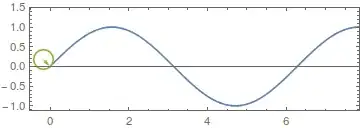What is locus of a fixed point on a circle of radius $r$ rolling over the curve $y=\sin x$? I have been struggling on the problem for many days, but I could not solve it. Geometrically, the locus seems to be a series of cycloid-looking figures mounted on the exterior of the sine curve, but analytically it seems very difficult to find the equation of the locus.
-
2Since the motion you describe involves matching the circle's arclength (easy) to the arclength of the sine curve, you are drawn into evaluation of an elliptic function. So computationally what you want to do is tractable, but analytically it is going to involve those elliptic functions. – hardmath Dec 30 '13 at 15:34
-
I think there should be a condition on the radius of the circle. for large values of $r$ the circle will not move. The start point is to consider special cases and small intervals. For example you can consider only the interval from $x=0$ to $x= \pi$ and notice that the distance moved on both curves are equal. the arc length of $y=sinx$ is easy and the distance on the circle is $r \theta$. try to answer "where on $y=sinx$ the circle complete a revolution" – Semsem Dec 30 '13 at 21:07
-
The point on the curve where the circle completes one revolution is given by ∫_0^x▒〖√(1+〖cos〗^2 ) x〗 dx=2πr – AgnostMystic Jan 01 '14 at 12:15
-
salam sajjad. did you see http://meta.math.stackexchange.com/questions/5020/mathjax-basic-tutorial-and-quick-reference – Jun 10 '14 at 15:07
2 Answers
I'm seeing this confusion in the answers and comments, so I might as well address it first: elliptic integrals and elliptic functions are not the same thing, in much the same way that one does not consider trigonometric functions and inverse trigonometric functions to be the same group.
Having gotten that pet peeve out of my chest, here's a nice cartoon to help you (and more so me) relax:

Using the general approach given in this answer, and using the arclength expression demonstrated in this answer, the parametric equations for the "sinusoidal cycloid" can be expressed in matrix-vector format as
$$\begin{pmatrix}t\\\sin t\end{pmatrix}+\frac1{\sqrt{1+\cos^2 t}}\begin{pmatrix}1&-\cos t\\\cos t&1\end{pmatrix}\begin{pmatrix}-r \sin\left(\frac{\sqrt{2}}{r}E\left(t\mid\frac12\right)\right)\\r-r \cos\left(\frac{\sqrt{2}}{r}E\left(t\mid\frac12\right)\right)\end{pmatrix}$$
where $E(\phi\mid m)$ is the incomplete elliptic integral of the second kind, which is a nonelementary function.
- 75,051
-
-
I used Mathematica to generate the cartoon, @marty. – J. M. ain't a mathematician Dec 12 '15 at 07:45
It involves an elliptic integral of the second kind.
Let $M = M(\theta) = (\theta, \sin \theta)$ be the contact point. The tangent at this point is $T = (1, -\cos \theta)$ so the center $I$ of the circle is such that $\vec{MI} = (\frac {r \cos \theta} {1+\cos ^2 \theta}, \frac {r} {1+\cos ^2 \theta})$.
The fixed point $P$ on the rolling circle is obtained for $M$ by rotation around $I$ of an angle $s$ equal to the length of $OM$ along the curves, that is $s = \int _0^\theta \sqrt{1 + \cos^2 \theta} d\theta$. Explicitly, $IP= (\frac {r \cos \theta} {1+\cos ^2 \theta} \cos s + \frac {r} {1+\cos ^2 \theta} \sin s , \frac {-r \cos \theta} {1+\cos ^2 \theta} \sin s + \frac {r} {1+\cos ^2 \theta} \cos s) $.
So the only step that makes the curve non-rational is the integral, which indeed is an elliptic function, impossible to express with elementary functions alone.
- 716
-
There is something wrong with the coordinates of M and I ;the distance MI does not come out to be r as it should be.Try distance formula and see for yourself. – AgnostMystic Jan 04 '14 at 11:40